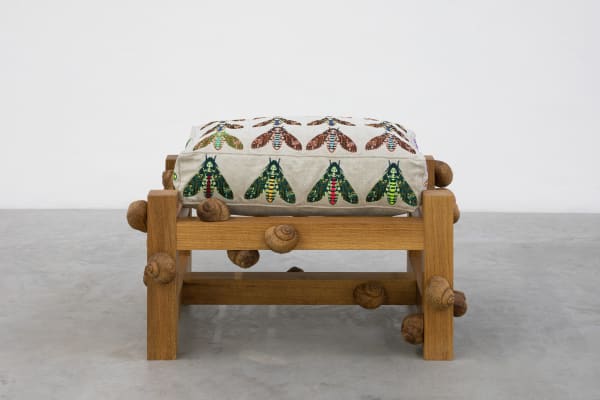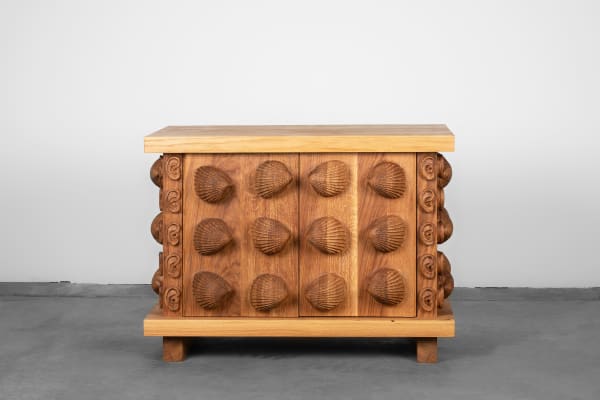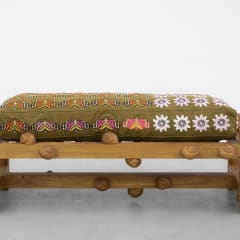Interspecific Bodies Daniel Dewar & Grégory Gicquel
Past exhibition
Overview
Mendes Wood DM is pleased to present Interspecific Bodies, the first exhibition of British-French duo Daniel Dewar and Grégory Gicquel in Brazil, bringing together a series of new works, including nine pieces in carved wood, and one sculpture in marble.
For over twenty years Dewar and Gicquel have explored and experimented with craft techniques, materials, and both modern and traditional tools in an ongoing foray into the artist’s and—more generally—humankind's relationship to labour and production. Each new work is created at the hands of the duo themselves after labour-intensive and empirical periods of trial, error, fecund failures, and meaningful surprises. Their repertoire of both arcane and highly technological crafts skills and their knowledge of materials is dizzying, including waterjet-cut stone marquetry, wood-fired ceramics, hand-woven aran wool, sculpted Portuguese marble, and computer assisted embroidery, to name but a few. In addition to their singular approach to materials and processes, Dewar and Gicquel have created a thrilling and complex representational shift, combining their media with a menagerie of incongruous motifs. Whether it’s the surprisingly tautological and brain-itching exercise of hand-modeling standard ceramic washbasins in ceramic; the surrealist rendering of legumes or human entrails in wood coupled with oaken chests; the associative depiction of butterflies in intricate, flitting stitches on textile; or the bold changes in scale that lead to gigantic concrete feet or sweaters, their practice uses these symbols and archetypes both as a motivation—a spark of excitement—and as an augury of their elaborate personal philosophy.
As viewers enter the exhibition space, they are confronted with Flipper, 2022, a diving fin rendered in pink Portuguese marble. This work can be seen as a prolongation of the duo’s 2017 series Nudes I-VI where non-finito body parts coupled with bathroom accessories riff off of the chance meeting between the academic subject (usually sculpted in white, noble marble) and the functional (basins, taps, showerheads). The jibe continues here with the puce stone so often employed in 1980s bathroom suites, that—contrary to our common penchant for restrooms as hygienic, sterile spaces—echoes real, veiny, caucasian flesh. The flipper therefore, by means of analogy evokes the absent human form, and by material contrast hints to the fluidity of water. The work also segues into the duo’s interest in the great human/animal divide by hinting at mankind’s dissatisfaction with and lust to enhance our bodies, surpass our limits, and mimic cetacean mobility.
In the next room, a series of three oak bas relief sculptures hang aligned on the wall. The hallucinatory whirls of the wood’s grain are heightened by each bizarre composition: one features sensual torsos across which glide a family of megalobulimus paranaguensis; another sees the creatures among a layering of genderless ears, toes, nipples, and abs; while the third depicts a lone mollusk navigating a tableau of feet whose digits seem to multiply in a movement somehow reminiscent of stop motion. Despite their inherently finished and still quality, these works glitch and vibrate, their incessant swirling both hypnotic and nauseating. The snails connote slowness, the veins in the wood evoke the steady passing of time, and the body parts rise and fall at the surface as if below a veil of water: we are but visitors to this earth.
In the series of oakwood benches and cabinets, Dewar and Gicquel continue to probe the distinction between inanimate objects and animate creatures or plants, as well as the historical separation of autonomous work of art and object of utility. The benches each comprise a sturdy and austere structure onto which carved snails cling, their fleshy bodies tucked away inside the whorls of their shells. Plump and intricately embroidered cushions complete the objects in terms of decoration and comfort, while unfolding the duo’s thoughts on species cohabitation. Perhaps reminiscent of their 1998 road trip from the south to north of Brazil, the artists have integrated local sphinx or “hawk” moths into this new iteration alongside the variegated Eurasian sphinx moth species, creating a decorative and speculative globalized ecosystem.
Two solid oakwood chests complete the body of works: from the panels of the first emerge a collection of butternut squashes, punctuated by the occasional nose. The second is studded with giant cockles—the archetypal sea shell—and offset by human ears (as the leap from conch to cochlea is swiftly made). Formal and etymological associations aside, the legumes and body parts remind us that the wood to make this furniture was also once growing, pulsating, and alive, thus addressing notions of interspecies awareness, care, and sensuality.
Interspecific Bodies causes the human and non-human to coalesce: melding together carefully selected animals, insects, and plants with natural materials, physical labour, and the functionality of the furniture-sculptures designed to welcome bodily forms and usages. In an anti-castrophisist stance, Daniel Dewar and Grégory Gicquel open up a speculative window upon an alternate future that feeds voraciously upon a pastoral past: man, woman, beast and plant are—in the duo’s vision—borne of the same earth, carved from the same stone. At a time when proximity between human and non-human life is so common, so invasive, so potentially destructive and yet so invisible (the (over)consumption of animal flesh, the destruction of natural habitats, the transmission of zoonoses between living beings), Dewar and Gicquel offer through their physical practice a humbling and refreshing view that unveils the shortcomings of human exceptionalism.
For over twenty years Dewar and Gicquel have explored and experimented with craft techniques, materials, and both modern and traditional tools in an ongoing foray into the artist’s and—more generally—humankind's relationship to labour and production. Each new work is created at the hands of the duo themselves after labour-intensive and empirical periods of trial, error, fecund failures, and meaningful surprises. Their repertoire of both arcane and highly technological crafts skills and their knowledge of materials is dizzying, including waterjet-cut stone marquetry, wood-fired ceramics, hand-woven aran wool, sculpted Portuguese marble, and computer assisted embroidery, to name but a few. In addition to their singular approach to materials and processes, Dewar and Gicquel have created a thrilling and complex representational shift, combining their media with a menagerie of incongruous motifs. Whether it’s the surprisingly tautological and brain-itching exercise of hand-modeling standard ceramic washbasins in ceramic; the surrealist rendering of legumes or human entrails in wood coupled with oaken chests; the associative depiction of butterflies in intricate, flitting stitches on textile; or the bold changes in scale that lead to gigantic concrete feet or sweaters, their practice uses these symbols and archetypes both as a motivation—a spark of excitement—and as an augury of their elaborate personal philosophy.
As viewers enter the exhibition space, they are confronted with Flipper, 2022, a diving fin rendered in pink Portuguese marble. This work can be seen as a prolongation of the duo’s 2017 series Nudes I-VI where non-finito body parts coupled with bathroom accessories riff off of the chance meeting between the academic subject (usually sculpted in white, noble marble) and the functional (basins, taps, showerheads). The jibe continues here with the puce stone so often employed in 1980s bathroom suites, that—contrary to our common penchant for restrooms as hygienic, sterile spaces—echoes real, veiny, caucasian flesh. The flipper therefore, by means of analogy evokes the absent human form, and by material contrast hints to the fluidity of water. The work also segues into the duo’s interest in the great human/animal divide by hinting at mankind’s dissatisfaction with and lust to enhance our bodies, surpass our limits, and mimic cetacean mobility.
In the next room, a series of three oak bas relief sculptures hang aligned on the wall. The hallucinatory whirls of the wood’s grain are heightened by each bizarre composition: one features sensual torsos across which glide a family of megalobulimus paranaguensis; another sees the creatures among a layering of genderless ears, toes, nipples, and abs; while the third depicts a lone mollusk navigating a tableau of feet whose digits seem to multiply in a movement somehow reminiscent of stop motion. Despite their inherently finished and still quality, these works glitch and vibrate, their incessant swirling both hypnotic and nauseating. The snails connote slowness, the veins in the wood evoke the steady passing of time, and the body parts rise and fall at the surface as if below a veil of water: we are but visitors to this earth.
In the series of oakwood benches and cabinets, Dewar and Gicquel continue to probe the distinction between inanimate objects and animate creatures or plants, as well as the historical separation of autonomous work of art and object of utility. The benches each comprise a sturdy and austere structure onto which carved snails cling, their fleshy bodies tucked away inside the whorls of their shells. Plump and intricately embroidered cushions complete the objects in terms of decoration and comfort, while unfolding the duo’s thoughts on species cohabitation. Perhaps reminiscent of their 1998 road trip from the south to north of Brazil, the artists have integrated local sphinx or “hawk” moths into this new iteration alongside the variegated Eurasian sphinx moth species, creating a decorative and speculative globalized ecosystem.
Two solid oakwood chests complete the body of works: from the panels of the first emerge a collection of butternut squashes, punctuated by the occasional nose. The second is studded with giant cockles—the archetypal sea shell—and offset by human ears (as the leap from conch to cochlea is swiftly made). Formal and etymological associations aside, the legumes and body parts remind us that the wood to make this furniture was also once growing, pulsating, and alive, thus addressing notions of interspecies awareness, care, and sensuality.
Interspecific Bodies causes the human and non-human to coalesce: melding together carefully selected animals, insects, and plants with natural materials, physical labour, and the functionality of the furniture-sculptures designed to welcome bodily forms and usages. In an anti-castrophisist stance, Daniel Dewar and Grégory Gicquel open up a speculative window upon an alternate future that feeds voraciously upon a pastoral past: man, woman, beast and plant are—in the duo’s vision—borne of the same earth, carved from the same stone. At a time when proximity between human and non-human life is so common, so invasive, so potentially destructive and yet so invisible (the (over)consumption of animal flesh, the destruction of natural habitats, the transmission of zoonoses between living beings), Dewar and Gicquel offer through their physical practice a humbling and refreshing view that unveils the shortcomings of human exceptionalism.
Works
-
 Daniel Dewar & Grégory Gicquel, Oak bench with banded sphinx moths and snails, 2021
Daniel Dewar & Grégory Gicquel, Oak bench with banded sphinx moths and snails, 2021 -
 Daniel Dewar & Grégory Gicquel, Oak bench with tiger heliconian butterflies, passion flowers and snails, 2021
Daniel Dewar & Grégory Gicquel, Oak bench with tiger heliconian butterflies, passion flowers and snails, 2021 -
 Daniel Dewar & Grégory Gicquel, Oak bench with ornatus hawmoths and snails, 2021
Daniel Dewar & Grégory Gicquel, Oak bench with ornatus hawmoths and snails, 2021 -
 Daniel Dewar & Grégory Gicquel, Oak bench with death head hawk moths and snails, 2021
Daniel Dewar & Grégory Gicquel, Oak bench with death head hawk moths and snails, 2021 -
 Daniel Dewar & Grégory Gicquel, Oak cabinet with cockles and ears, 2021
Daniel Dewar & Grégory Gicquel, Oak cabinet with cockles and ears, 2021 -
 Daniel Dewar & Grégory Gicquel, Flipper, 2021
Daniel Dewar & Grégory Gicquel, Flipper, 2021 -
 Daniel Dewar & Grégory Gicquel, Oak bench with gaudi sphinx moths and snails, 2021
Daniel Dewar & Grégory Gicquel, Oak bench with gaudi sphinx moths and snails, 2021 -
 Daniel Dewar & Grégory Gicquel, Oak cabinet with courgettes and snail, 2021
Daniel Dewar & Grégory Gicquel, Oak cabinet with courgettes and snail, 2021
Installation Views









